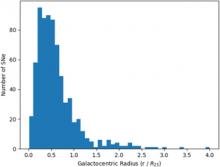
Abstract
Many spiral galaxies have extended outer H~I disks and display low levels of star formation, inferred from the far-ultraviolet emission detected by {\it GALEX}, well beyond the optical radius. Here, we investigate the supernova (SN) rate in the outskirts of galaxies, using the largest and most homogeneous set of nearby supernovae (SNe) from the Lick Observatory Supernova Search (LOSS). While SN rates have been measured with respect to various galaxy properties, such as stellar mass and metallicity, their relative frequency in the outskirts versus the inner regions has not yet been studied. Understanding the SN rate as a function of intragalactic environment has many ramifications, including the interpretation of LIGO observations, the formation of massive stars, and the puzzlingly high velocity dispersion of the outer H~I disk. Using data from the LOSS survey, we find that the rate beyond the optical radius of spiral galaxies is 2.5±0.5 SNe per millennium, while dwarf galaxies host 4.0±2.2 SNe per millennium. The rates of core-collapse SNe (that may collapse to form the massive black holes detected by LIGO/Virgo) in the outer disks of spirals is 1.5±0.15 SNe per millennium and in dwarf galaxies is 2.6±1.5 SNe per millennium. Core-collapse SNe in spiral outskirts contribute 7600±1700\,SNe\,~Gpc−3\,yr−1 to the volumetric rate, and dwarf galaxies have a rate of 31,000±18,000\,SNe\,Gpc−3\,yr−1. The relative ratio of core-collapse to Type Ia SNe is comparable in the inner and outer parts of spirals, and in dwarf galaxies.